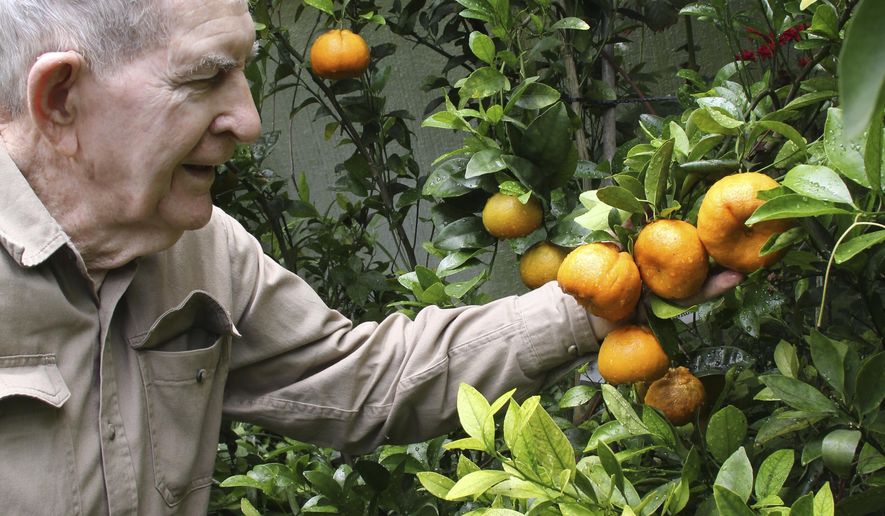ALLIANCE, Neb. (AP) - Members of the Nebraska Master Gardener Program anxiously wait as Alliance’s Russ Finch cuts an orange. While the excitement for a simple orange seems strange, this orange is different. It is a 3-year-old orange that Finch grew in his own backyard.
Finch was simply a mail carrier and farmer in Alliance, until 45 years ago when he started experimenting with heating houses with geothermal heat. Fifteen years later, he began using the geothermal heat to improve greenhouses.
Geothermal heat produces heat from the ground. A singular heat source dispenses heat into a tubing system that runs under the ground of the greenhouse. The heat is constantly circulating and reused to create the perfect environment for the greenhouse. This means that in Finch’s greenhouses, he can grow any tropical or subtropical plant that he wants.
His personal greenhouse is filled with numerous plants, nine varieties of southern grapes, pomegranates, 13 types of citrus fruit and much more. His citrus fruits include Eureka lemons, Meyer’s lemons, Cara Cara oranges, Tango mandarins and Washington navel oranges.
At 78-feet long, Finch’s greenhouse is 24 years old and the first one he created.
Around three years ago, Finch began to sell the frames, systems and equipment for his geothermal greenhouses with his business, Greenhouse in the Snow.
Compared to his personal greenhouse, the new greenhouses are much more efficient.
The new greenhouses are at least 96 feet long. They also include shelves on one wall to grow ground vegetables and fruit. The other side of the greenhouse is often designated for trees.
“We just put everything in it to see if it’ll grow, and almost everything did,” Finch told the Scottsbluff Star-Herald (https://bit.ly/2rxhnK9 ).
Finch’s geothermal greenhouses appear to be much more efficient than the standard greenhouse.
To run his personal greenhouse, it costs Finch up to 85 cents a day. Other geothermal greenhouses, like the one at Alliance High School, cost up to 97 cents a day. A geothermal greenhouse only costs around $200 to run in the winter, compared to the $8,000 it would cost with a regular greenhouse.
In his greenhouses, Finch can also produce more product than planting outside.
A greenhouse can produce 14 tomatoes to every one tomato that average farming produces, while with other crops it is often a 50 to 1 ratio, Finch said. Weather is a big factor in this because greenhouses have a controlled environment.
The profit produced by the geothermal greenhouses is a great benefit as well.
“Each tree needs an 8-foot circle and will produce 125 pounds of fruit. If a pound is usually $3.50 at a farmers market, that makes each 8-foot circle worth $430,” Finch said.
According to Finch, most young people do not want to get into agriculture because they believe it is too expensive. Little do they know, a single 3-year-old tractor with four-wheel drive is the same cost as putting up nine of Finch’s greenhouses. So for those looking to get into agriculture, Finch highly suggests going geothermal.
Greenhouses are efficient cost wise, but the newer greenhouses also include a key to helping deal with the extinction of bees.
Finch showcased an Australian beehive called Flow Hive. The hive would replace common beehives and take away the need for smokers, a device used to calm bees. Within Flow Hive, the hexagonal cells are already formed, so the bees do not need to create them with wax.
When the honey needs to be taken from the beehive, a key is used to break the cells and drain the honey. Finch claims that the new beehives would help kill less bees and hopefully, help the bee from coming extinct.
Finch has sold about 38 greenhouses and almost all of them have been used for commercial purposes. Nine states - including Alaska, South Dakota, Wyoming and Kansas - now have Finch’s greenhouses, along with two greenhouses in Canada.
The Federal Aviation Administration has just given the go for a greenhouse to be built at the Western Nebraska Regional Airport in Scottsbluff. The greenhouse will be used by the North Platte Natural Resources department. It is estimated that the greenhouse will be put in place in late spring.
With the success of Greenhouse in the Snow, Finch is very hopeful for the possibilities. He is trying to spread his geothermal heat across the globe to countries like Australia, Belgium, Croatia, Denmark, Greece and South Africa.
According to Finch, all of the Midwest’s table citrus could be grown locally in greenhouses.
___
Information from: Star-Herald, https://www.starherald.com




Please read our comment policy before commenting.